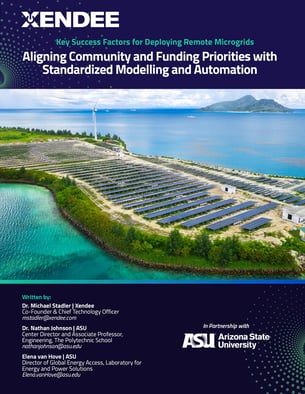Download the Whitepaper
The Challenge of Powering an Archipelago and the Project Team's Plan for a Solution
Progress has been made in expanding access to electricity across the globe. However, much of the world – particularly in Africa and isolated pockets of islands in the Asia Pacific – still do not have access to electricity. While over 90 percent of the world’s population has access to electricity today, the International Energy Agency (IEA) estimates roughly 775 million people currently lack electricity. On top of that, most citizens living in emerging economies such as the Pacific Island Countries still burn polluting fossil fuels to generate electricity. By 2030, The United Nations estimates that 660 million people will still not have access to electricity unless new innovative solutions incorporating distributed on-site renewable energy or Microgrids are brought to market that marry stakeholder engagement with new data-driven modelling and design technologies.
 Map of Fiji showing the 75 visited microgrid sites from the 300+ considered in the program. (Image courtesy of Arizona State University)
Map of Fiji showing the 75 visited microgrid sites from the 300+ considered in the program. (Image courtesy of Arizona State University)
Minigrids or Microgrids that use DER to power remote areas of the world are oftentimes challenging due to a lack of data or because of the remote location itself. Funding and community support can be a challenge too. In addition, even with data, the burdensome task of analyzing many possible sites in an efficient way, can be the difference between moving the project forward or stalling out.
In this white paper guide, some of these key questions and challenges that have plagued projects in the past will be pointed out, using a project to electrify 75 communities with hybrid solar Microgrids in the outer islands of Fiji as an example to illustrate them and proven solutions for how to overcome them. Initially, key success factors have been boiled down into 4 main aspects of a successful project.
Key Success Factor 1: Early Community Buy-In
Early community engagement is key to the success of renewable energy projects like hybrid solar microgrids. By involving communities from the start and demonstrating the benefits—such as improved services, local jobs, and reduced health risks—these projects can gain essential buy-in.

Example of a typical island community in Fiji. (Image courtesy of Arizona State University)
Key Success Factor 2: Partnerships are Key
Strategic partnerships are essential for successful hybrid solar mini-grid deployments in remote areas like Fiji’s outer islands. By collaborating with key organizations such as Arizona State University, Xendee, and the UNDP, these projects benefit from local engagement, data-driven insights, and sustainable financing models.
Key Success Factor 3: Techno-Economic Modelling
Techno-economic modeling is key to scaling hybrid solar mini-grid projects cost-effectively. By applying advanced, standardized design principles across a portfolio, developers can capture economies of scale and streamline installations. These models optimize project costs, energy reliability, and resilience to natural disasters while making the projects more attractive to investors.
Key Success Factor 4: Overcoming Lack of Historical Data
In remote regions like Fiji, where historical energy usage data is scarce, innovative solutions are needed to justify investments in energy access projects. For over 300 communities without grid connection, advanced computer models and APIs are crucial to generate reliable data and run multiple design scenarios efficiently.
Learn more about the key success factors, and Xendee's suite of solutions by downloading the full whitepaper report below.




